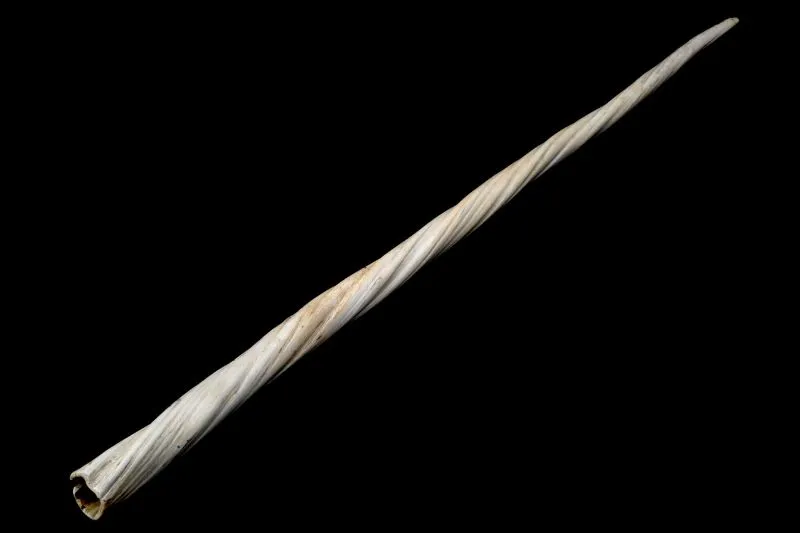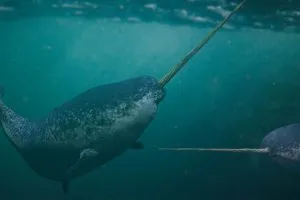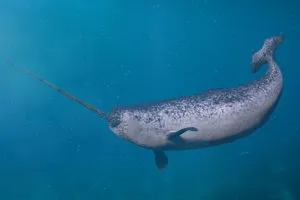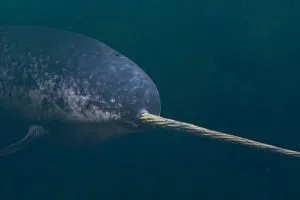Narwhals are iconic marine mammals because of their impressive horn/tusk. They are known as the Unicorn of the Sea, and have been an impressive character of many stories going back many years. You will be interested to hear that narwhals use their tusk for many purposes.
There is a long, ongoing conversation about how a narwhal uses its tusk. Some of the main reasons include heading it to eat (by stunning its prey), and helping it breathe (by breaking up sea ice). Narwhals could also use their tusk for communication, as research shows it has millions of nerve endings.
Keep on reading to find out more about narwhal tusks, including some details about the mysterious double-tusked narwhals and the history behind the trade of the “unicorn horns”. You will be surprised to read that the main purpose of the narwhal’s tusk is not for fighting!
- Why Does a Narwhal Have a Horn?
- Why Are Narwhals Called the Unicorn of the Sea?
- Why Do Some Narwhals Have Two Tusks?
- Why Do Some Narwhals Not Have Tusks?
- Do Female Narwhals Have A Tusk?
- What Are Narwhal Tusks Made Of?
- When Do Narwhals Get Their Tusk?
- How Long Do Narwhal Tusks Get?
- Do Narwhal Tusks Fall Off?
- Related Questions
Why Does a Narwhal Have a Horn?
There is a long, ongoing conversation about the reason why narwhals have horns (more accurately referred to as tusks, as explained later in this article). The simple answer is that narwhals have tusks because they help them to survive in the harsh conditions of the polar region. The way that narwhals use their tusk can vary. Here are a few examples.
- Narwhals have been observed to use their tusk to help them hunt for prey. They have done this being using their tusk to stun smaller fish such as Arctic cod1 (source: WWF).
ㅤ - Another use of the narwhal’s tusk is to help it breathe. As the narwhal is a marine mammal, it has to come to the surface to breathe air. Sometimes in the Arctic, there is sea ice on the water which could prevent the narwhal from breathing. In these circumstances, the narwhal could use its tusk to break the sea ice2 (source: Wikipedia).
ㅤ - One theory is that narwhals use their tusk for conflict or dominance purposes. For example, it is thought that narwhals use their tusks to fight other narwhals or to protect their territory. Also, the size of the narwhal could be used as an indication of its position in the hierarchy3 (source: National Oceanic and Atmospheric Administration).
There have been detailed analyses which highlight non-violent usages of the narwhal’s tusk. Some research has shown that the tusk has millions of nerve endings. It is thought that narwhals which rub their tusks together are actually communicating with each other; sharing information about the parts of the ocean they have been in4 (sources: The Independent and New York Times).

Why Are Narwhals Called the Unicorn of the Sea?
Narwhals are called the Unicorn of the Sea, simply because of their horn/tusk. Narwhals are iconic marine mammals because of their tusk which is on the front and centre of its head. Also, the tusk of a narwhal is notably very straight with an impressive twisted-spiral shape5 (source: M.C.S. Kingsley and M.A. Ramsay, Arctic, Vol. 41, Issue 3, 1988).
Narwhal tusks were found by Vikings around 1000 A.D and sold to Europeans including to royalty such as Queen Elizabeth I. One interesting reason for this is the rumour that thei would protect people from poison. The Queen valued the narwhal tusks so highly that they were to be preserved with the crown jewels. The trade expanded into the Middle Ages as the narwhal became a symbol associated with Christ.
The narwhal tusks continued to be presented as state gifts and pursued by royalty including King Francis I of France, Ivan the Terrible, Phillip II of Spain, Christian V and the royal Habsburg family.
The trade for narwhal tusks for poison-protection purposes decreased around the 17th century when evidence proved that it was only a myth6 (source: History).
There is international trade of narwhal tusks to-date, however, there are recent calls for increased monitoring to the climate-change-associated threats to narwhal populations7 (source: Traffic).
Why Do Some Narwhals Have Two Tusks?
Some narwhals have two tusks because they have two canine teeth. As tusks are elongated canine teeth, it is possible for two to become elongated. It is thought that 1 in 500 narwhals produce two tusks at the same time. Most of the time, only a single canine tooth grows into a tusk. The tusk grows from the left side of the upper jaw. Both male and female narwhals can have two tusks8 (sources: M.T. Nweeia, et al, The Anatomical Record, Vol. 295, Issue 6, 2012, pp. 1006-1016 and M. Carwardine, Whales, dolphins, and porpoises, 1998).
Why Do Some Narwhals Not Have Tusks?
Some narwhals do not have tusks because the presence of a tusk is thought to be more of a sexual trait. Most of the time, it is male narwhals which grow tusks. That means that if you see a narwhal without a tusk, then it is most likely a female. The reason why females do not have
Do Female Narwhals Have A Tusk?
Yes, female narwhals can have a tusk. It is possible for their canine tooth to grow and protrude, suchlike as a male narwhal’s tooth does. However, the tusks that female narwhals produce are often shorter than a male’s tusk9 (source: Z.A. Graham, et al, Biology Letters, Volume 16, Issue 3, 2020). It is thought that 15% of female narwhals have tusks.
There is even a photographic record, and a preserved example from 1684, of a female narwhal with two tusks10 (source: M. Carwardine, Whales, Dolphins, and Porpoises, 1998).
What Are Narwhal Tusks Made Of?
The tusk or horn of a narwhal is actually an elongated canine tooth11 (source: M.T. Nweeia, et al, The Anatomical Record, Vol. 295, Issue 6, 2012, pp. 1006-1016). The narwhal tusk is made of similar things to elephant and walrus tusks; a material called dentine. These tusks are not covered in enamel except sometimes at the sharpest point of the tusk. Unlike the tusks of other mammals, the narwhal tusk is hollow and contains a long, central pulp cavity12 (source: Science Direct, 2013).
When Do Narwhals Get Their Tusk?
Narwhal tusks develop as they get older. The canine teeth of baby narwhals grows until it pierces and protrudes through the narwhal’s lip. Narwhals are not born with a tusk suchlike the ones you would typically see on an adult male; it takes some time to grow13 (source: Wikipedia).
How Long Do Narwhal Tusks Get?
Narwhal tusks grow to lengths between 1.5 to 3.1 metres (4.9 to 10.2 feet). That is the same length as three guitars! Narwhal tusks are reported to grow continuously throughout their lifespan. Despite reaching this impressive length, they are not extremely heavy. This is because narwhal tusks are hollow. Records show that a narwhal tusk can weigh around 10 kilograms (22 pounds)14 (source: Wikipedia). This is equal to a typical car tyre.
Do Narwhal Tusks Fall Off?
Yes, narwhals can lose their tusk. There is the potential to lose their tusk for various reasons.
Some of the reasons why narwhals could lose their tusk is breaking sea ice or fighting. This could cause the narwhal tusk to break. Some other marine mammals, like walruses, can lose their tusks naturally over time15 (source: Point Defiance Zoo and Aquarium).
Walrus tusks, which are similar to narwhal tusks, can be regrown, however, there is no evidence of a narwhal regrowing its tusk.
Related Questions
Does A Narwhal Have A Horn Or A Tusk?
Narwhals have tusks, not horns. They are often referred to as horns because of their placement on their head, however, they are tusks which are elongated canine teeth, not horns which are made of bone and form part of the skull of an animal16 (source: Wikipedia).
Where Does The Narwhal Tusk Come Out Of?
The narwhal tusk comes out at the front and centre of its head – in between the eyes. The canine tooth protrudes from the upper jaw and through the lip of the narwhal17 (source: Wikipedia).
Do Narwhals Use Their Tusk to Fight?
Yes, there is some evidence that narwhals use their tusks during fights. Some research shows that adult mature males have high numbers of scars on their heads, broken tusks, and tusk tip found in their skulls18 (source: H.B. Gerson and J.P. Hickie, Canadian Journal of Zoology, 1985).
There is research which suggests that tusks are used as a key component of male-to-male aggression. However, the main use for tusk is not thought to be for conflict19 (source: Z.A. Graham, et al, Biology Letters, Volume 16, Issue 3, 2020).
Do Narwhals Use Their Tusk to Break Ice?
No, narwhals do not use their tusks to break the sea ice. However, a marine mammal in the Arctic which does use its tusk to break the ice is the walrus.
Do Narwhals Use Their Tusk to Hunt?
Yes, narwhals can use their tusk to hunt. Narwhals have been observed to stun their prey. Stunning their prey with their tusk makes them easier to eat. Narwhals are known to stun small Arctic cod in Tremblay Sound, Nunavut20 (source: National Post). However, narwhals are thought to use their tusks more commonly for other purposes.
Can Narwhals Have 3 Tusks?
No, narwhals can not have three tusks. This is because the tusks are elongated canine teeth. Narwhals have two canine teeth, which explains why sometimes narwhals can grow two tusks. However, typically only one tusk is grown.


![You are currently viewing Why Does a Narwhal Have a Horn? [Unicorns of the Sea Explained]](https://polarguidebook.com/wp-content/uploads/2022/10/Narwhals-Together.jpg)


